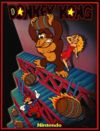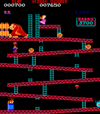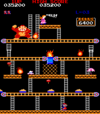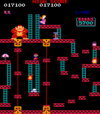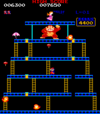Difference between revisions of "Donkey Kong (game)"
m |
|||
| Line 6: | Line 6: | ||
|developer=[[R&D 1|Nintendo R&D 1]] | |developer=[[R&D 1|Nintendo R&D 1]] | ||
|publisher=[[Nintendo]] | |publisher=[[Nintendo]] | ||
| − | |system=[[Arcade]]<br />[[NES]]<br />[[e-Reader]]<br />[[Gameboy Advance]]<br />[[Virtual Console]]<br />[[3DS Virtual Console]]<br />[ | + | |system=[[Arcade]]<br />[[NES]]<br />[[e-Reader]]<br />[[Gameboy Advance]]<br />[[Virtual Console]]<br />[[3DS Virtual Console]]<br />[[Wii U Virtual Console]]<br />Various Non-Nintendo Systems |
|release='''Arcade'''<br />1981<br />'''NES'''<br />JP July 15, 1983 <br />US June 1986<br />EU October 15, 1986<br />'''E-Reader'''<br />US November 12, 2002<br />'''Gameboy Advance'''<br />JP December 14, 2004<br />US June 2, 2004<br />EU July 9, 2004<br />'''Wii Virtual Console'''<br />US November 19, 2006<br />JP December 2, 2006<br />EU December 8, 2006<br />'''3DS Virtual Console'''<br />JP October 17, 2012<br />US April 15, 2013<br />EU November 21, 2013<br />'''3DS Virtual Console (''Original Edition'')'''<br />EU September 18, 2014<br />Wii U Virtual Console<br />July 15, 2013 | |release='''Arcade'''<br />1981<br />'''NES'''<br />JP July 15, 1983 <br />US June 1986<br />EU October 15, 1986<br />'''E-Reader'''<br />US November 12, 2002<br />'''Gameboy Advance'''<br />JP December 14, 2004<br />US June 2, 2004<br />EU July 9, 2004<br />'''Wii Virtual Console'''<br />US November 19, 2006<br />JP December 2, 2006<br />EU December 8, 2006<br />'''3DS Virtual Console'''<br />JP October 17, 2012<br />US April 15, 2013<br />EU November 21, 2013<br />'''3DS Virtual Console (''Original Edition'')'''<br />EU September 18, 2014<br />Wii U Virtual Console<br />July 15, 2013 | ||
|gallery=[http://www.gamehiker.com/gallery/index.php?cat=110 GH Gallery] | |gallery=[http://www.gamehiker.com/gallery/index.php?cat=110 GH Gallery] | ||
Revision as of 18:47, 16 December 2014
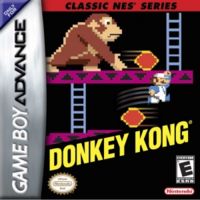
| |
| Donkey Kong | |
| Developer | Nintendo R&D 1 |
| Publisher | Nintendo |
| System | Arcade NES e-Reader Gameboy Advance Virtual Console 3DS Virtual Console Wii U Virtual Console Various Non-Nintendo Systems |
| Release Date | Arcade 1981 NES JP July 15, 1983 US June 1986 EU October 15, 1986 E-Reader US November 12, 2002 Gameboy Advance JP December 14, 2004 US June 2, 2004 EU July 9, 2004 Wii Virtual Console US November 19, 2006 JP December 2, 2006 EU December 8, 2006 3DS Virtual Console JP October 17, 2012 US April 15, 2013 EU November 21, 2013 3DS Virtual Console (Original Edition) EU September 18, 2014 Wii U Virtual Console July 15, 2013 |
| Gallery | GH Gallery |
| Rating | E |
Donkey Kong was a 1981 game made by Nintendo. It is known as the true beginning of the Mario series. The game introduces the main character, Mario (or Jumpman as he was called in the original release) as well as some basic gameplay mechanics of the series (such as jumping and saving damsels), and of course the introduction of the titular Donkey Kong.
Conception
Donkey Kong was the first game made by Shigeru Miyamoto. Originally Miyamoto was to make a game that would fill the 2,000 empty arcade cabinets for Nintendo's Radar Scope, which had done terribly sales-wise. Originally the game was going to be a Popeye game based on the famous comic strip and cartoons. But after the rights fell through, Miyamoto replaced the three main characters (Popeye, Bluto and Olive Oil) with his own original characters. Although it became very popular in Japan, Nintendo of America was skeptical about the game. Their skepticism ceased after the roaring sales of the game.
At one point Nintendo faced problems in the form of a lawsuit from Universal Studios, who believed that the Donkey Kong game was plagiarizing their movie, King Kong (which was about a giant gorilla known as King Kong who also liked high buildings and capturing blonde women). However, Nintendo was able to defend the game's originality and win the case. Ironically, the next game would feature Donkey Kong's son in Donkey Kong Junior, while the sequel to King Kong was called Son of Kong and featured King Kong's son.
Story
Donkey Kong was one of the earliest games with an actual story, and so it was a simple one; the ape Donkey Kong had kidnapped Pauline. Pauline's boyfriend, Mario (or Jumpman as he was called in the original release), decided to chase down Donkey Kong in order to save Pauline. At the end of the game, Donkey Kong topples from the building while Mario is reunited with Pauline.
Gameplay
The player controls Mario as he ascends four levels in search of Donkey Kong. Mario's primary move is jumping. Unlike other games, he cannot stomp on enemies. His jumping abilities are only used to dodge enemies and obstacles, and to leap across gaps. Mario can only go on the offensive with the aid of the game's only weapon, the Hammer. The hammer turns Mario invincible and allows him to destroy any enemy that wanders into the hammer's path. However, the weapon's effects are temporary, and Mario's cannot jump high or climb ladders while using it. Mario can also collect Pauline's dropped items (a bonnet, a purse and an umbrella) for extra points.
Levels
There are four levels in the game, each one taking up one screen and seeming to take place in a construction site of some sort due to all the girders. Each level is accompanied by an increase in altitude; the first level goes up to 25 meters high, the second 50 meters high, the third 75, and finally the fourth 100 meters. The first levels are completed by bringing Mario up to Pauline's level while avoiding Donkey Kong and his minions. Donkey Kong would than grab Pauline and take her up to the next level. In the final level, Mario must "defeat" Donkey Kong by destroying the ground beneath him.
- Level 1 (25m) - The most well-known level. This area is a series of girders that have been bent by Donkey Kong's poundings. To climb the area Mario must either jump his way up or climb a series of ladders. Donkey Kong throws barrels that Mario must jump. Some barrels enter a flaming oil drum at the bottom of the screen, producing a flaming enemy (similar to the Podoboo of the later games) that will follow Mario. The flame enemies also appear in all following levels.
- Level 2 (50m) - This level contains several conveyor belts which switch direction randomly. The conveyor belts also carry giant pies that will harm Mario. Another threat in the level comes from several retractable ladders, and from a flaming oil drum in the center of the screen.
- Level 3 (75m) - This level contains a series of rising and sinking elevators. Mario must jump from one to another with perfect timing in order to avoid falling to his doom. At the top of the screen, Donkey Kong tosses trampolines that Mario must use even more perfect timing to dodge.
- Level 4 (100m) - The game's final level is a blue area with straight girders. This level is completed differently than the others; this time Mario's goal is to run over eight yellow blocks which are placed in the girders of this level. This will make the blocks disappear. After all the blocks disappear, the platform Donkey Kong stands on can no longer support his weight, leading him to fall on his head. After the game is completed, it will restart.
Legacy
Ports/Remakes
- Donkey Kong was released on various consoles throughout the 80's - the Atari 2600, Atari 8-bit, Atari 7800, Colecovision, Intellivision, Spectrum, Commodre 64, Apple II and PC. Most versions featured graphics inferior to the console version, and the second "pie factory" level was removed in most versions.
- The original arcade version was also included in Donkey Kong 64, where the arcade machine could be activated in the Frantic Factory level.
- A Game & Watch version was released in 1982. This game featured two screens in a new version of the "girder level".
- Donkey Kong was released for the NES in 1983 in Japan, and in 1986 in America. This version also excluded the second level, although it was graphically identical to the arcade version.
- Unfortunately, this three-level NES version is the one usually rereleased; it was later packaged with Donkey Kong Jr. as Donkey Kong Classics in 1988.
- The NES Donkey Kong was released in 2001 as an unlockable in Animal Crossing, in 2002 as an e-Reader game, in 2004 for the Gameboy Advance as part of the Classic NES Series, in 2006 on the Wii's Virtual Console, in 2012 for the 3DS Virtual Console and in 2013 for the Wii U Virtual Console. A demo version of the Virtual Console was included as an unlockable Masterpiece in Super Smash Bros. Brawl.
- In 1994, Donkey Kong GB was released for the Gameboy. It acted as part-remake and part-sequel to the original arcade game; it had the original four levels from Donkey Kong, and afterwards it introduced 96 original levels.
- In 2010, a special Virtual Console called Donkey Kong: Original Version started receiving limited release. This version did not have the quality of the arcade version, but it was modified from the NES version and had all four levels. This version was originally available exclusively pre-installed on Wiis sold in Europe only in 2010. In 2012, this version was made available for the 3DS Virtual Console as part of a special Club Nintendo promotion when certain other games were bought during a limited time frame. In Japan, this was between July and September 2012, while in America it was between October 2012 and January 2013. Original Version only received a full release in Europe for the 3DS Virtual Console in September 2014.
Sequels
Donkey Kong was succeeded by Donkey Kong Jr. in 1982 and Donkey Kong 3, which featured Stanley instead of Mario, in 1983. Neither of these games were as successful as the first, so the series went into decline until the Donkey Kong name was revived by Donkey Kong GB and Donkey Kong Country. Prior to that, a sequel to the arcade games called Return of Donkey Kong was planned for the NES, but it was soon canceled (and possibly reworked into Donkey Kong GB)
In later years, the original premise of the Donkey Kong series was revived in Mario Vs. Donkey Kong, although that game seemed to be more inspired by Donkey Kong GB than the original Donkey Kong.
Other
There are additionally many references and homages to Donkey Kong in various Nintendo games, particularly the first level with the falling barrels. Super Mario RPG: Legend of the Seven Stars and The Legend of Zelda: Oracle of Seasons both contained their own versions of the barrel stage. The level 75m is featured in Super Smash Bros. Brawl as a faithful recreation of the level in pixelated form as one of the game's unlockable battle stages.
In 1983, the cartoon Saturday Supercade featured a segment based on Donkey Kong. This portrayed Donkey Kong more as a lovable, mischief-making cartoon who was constantly on the run from Mario. Mario served as the Ranger Smith character who tried catching Donkey Kong many times, with embarrassing results. Mario was accompanied by Pauline, who was shown as his niece for some reason.
| Titles in the Donkey Kong Series |
|---|
| Donkey Kong (GB) - Jr. - Math - 3 Donkey Kong Country (2: Diddy Kong's Quest - 3: Dixie Kong's Double Trouble) - Land (2 - III) - Donkey Kong 64 Mario vs. Donkey Kong - March of the Minis - Minis March Again! - Mini-Land Mayhem! - Minis on the Move - Tipping Stars Jungle Beat - King of Swing - Jungle Climber - Returns - Tropical Freeze Diddy Kong Racing - Donkey Konga (2 - 3) - Barrel Blast |
| Titles in the Mario Series |
|---|
| Donkey Kong (GB) - Jr. - Mario Bros. - Mario Clash Super Mario Bros. (DX) (Lost Levels - 2 - 3) - Super Mario World - Yoshi's Island - Super Mario Land (2) Super Mario 64 (DS) - Sunshine - Galaxy (2) - 3D Land (World) - Odyssey Super Mario Advance (2 - 3 - 4) - New Super Mario Bros. (Wii - 2 - U) - Run - Wonder Mario vs. Donkey Kong - March of the Minis - Minis March Again! - Mini-Land Mayhem! - Minis on the Move - Tipping Stars Mini Mario & Friends: amiibo Challenge - Super Mario Maker (2) |
